Related Research Articles
Zula ግእዝ ዙላ saba ሰብኣ 𐩸𐩡 is a small town in central Eritrea. It is situated near the head of Annesley Bay, on the Red Sea coast. Four kilometers away is the archeological site of Adulis, which was an emporium and the port of Axum.

The Ural, known before 1775 as Yaik, is a river flowing through Russia and Kazakhstan in the continental border between Europe and Asia. It originates in the southern Ural Mountains and discharges into the Caspian Sea. At 2,428 kilometres (1,509 mi), it is the third-longest river in Europe after the Volga and the Danube, and the 18th-longest river in Asia. The Ural is conventionally considered part of the boundary between the continents of Europe and Asia.

Khwarazm or Chorasmia is a large oasis region on the Amu Darya river delta in western Central Asia, bordered on the north by the (former) Aral Sea, on the east by the Kyzylkum Desert, on the south by the Karakum Desert, and on the west by the Ustyurt Plateau. It was the center of the Iranian Khwarezmian civilization, and a series of kingdoms such as the Afrighid dynasty and the Anushtegin dynasty, whose capitals were Kath, Gurganj and – from the 16th century on – Khiva. Today Khwarazm belongs partly to Uzbekistan and partly to Turkmenistan.

Khiva is a district-level city of approximately 93,000 people in Xorazm Region, Uzbekistan. According to archaeological data, the city was established around 1500 years ago. It is the former capital of Khwarezmia, the Khanate of Khiva, and the Khorezm People's Soviet Republic. Itchan Kala in Khiva was the first site in Uzbekistan to be inscribed in the World Heritage List (1991). The astronomer, historian and polymath, Al-Biruni was born in either Khiva or the nearby city of Kath.
Ankober, formerly known as Ankobar, is a town in central Ethiopia. Located in the North Shewa Zone of the Amhara Region, it's perched on the eastern escarpment of the Ethiopian Highlands at an elevation of about 2,465 meters (8,100 ft). It is 40 kilometers (25 mi) to the east of Debre Birhan and about 90 miles (140 km) northeast of Addis Ababa.
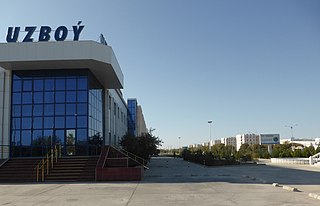
Daşoguz, formerly known as Tashauz and Dashkhovuz, is a city in northern Turkmenistan and the capital of Daşoguz Province. The Uzbekistan border is about 10 km away.

The Dzungarian Alatau is a mountain range that lies on the boundary of the Dzungaria region of China and the Zhetysu region of Kazakhstan. It has a length of 450 km (280 mi) and a maximum elevation of 4,464 m (14,646 ft).
Sarmishsay is located in the Karatau Mountain Range in the Nurata District of Navoiy Region of Uzbekistan. The gorge contains archeological remains dating back as far as the Stone Age, including two petroglyph sites with a total of 10,000 ancient rock carvings. According to UNESCO, it is the largest and most important rock art monument in Uzbekistan.
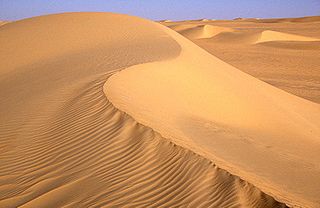
The Erg of Bilma is a dune sea in the Ténéré desert region of the south central Sahara Desert. The Erg of Bilma stretches southwest from Fachi and the Tibesti Mountains. On the west it is bounded by the Aïr Mountains in north central Niger, and to the east it passes Bilma, continuing on to the Chadian border. It surrounds on three sides the oasis of Bilma, southernmost of a north–south string of oases of the Kaouar rise. The Erg covers an area of approximately 455,000 square kilometres (176,000 sq mi).

Bradt Travel Guides is a publisher of travel guides founded in 1974 by Hilary Bradt and her husband George, who co-wrote the first Bradt Guide on a river barge on a tributary of the Amazon.

ʿAmrān is a small city in western central Yemen. It is the capital of the 'Amran Governorate, and was formerly in the Sana'a Governorate. It is located 52.9 kilometres (32.9 mi) by road northwest of the Yemeni capital of Sana'a, at the upper (southern) end of the al-Bawn plain. According to the 2004 census it had a population of 76,863, and an estimated population of 92,763 in 2013.
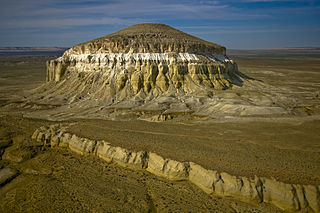
Sherkala is a mountain in Mangystau Province, western Kazakhstan, close to the town of Shetpe. It has been described as looking like a piala, yurt or Sphinx with steep south and east sides and a more eroded northern side.

Jankent is a deserted town east of the Aral Sea in modern Kazakhstan. It is known from Arab writings of the 10th century AD as the capital of the steppe empire of the Oghuz Turks. Archaeological research has provided information about the appearance of the town and confirmed the date, but also points to earlier origins.

The Congo-Nile Divide region of Rwanda and Burundi is a mountainous area in the southern section of the Congo-Nile Divide, to the east of the Albertine Rift. The region includes the Nyungwe and Kibira national parks. The Bugoyi people live in the region.
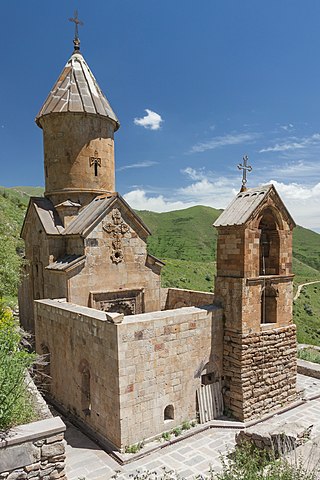
Spitakavor Monastery, is a 14th-century Armenian monastic complex, 7 kilometres (4.3 mi) north of Vernashen village, near the town of Yeghegnadzor of Vayots Dzor Province, Armenia.
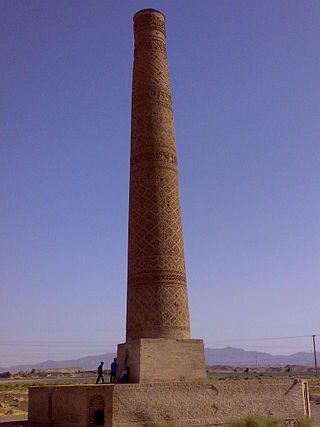
Khosrogerd Minaret is a 12th-century tower located 10 kilometres (6.2 mi) to the west of Sabzevar, Iran, and is all that remains of the Silk Road town of Khosrogerd, destroyed by the Mongols in 1220 AD. It is an example of Seljuk architecture.

The Karsakpay inscription is a message carved on April 28, 1391 into a fragment of rock in Ulu Tagh mountainside near the Karsakpay mines, Kazakhstan. It was found in 1935. It consists of three lines in Arabic, and eight lines in Chagatai, written in the Old Uyghur alphabet.

Mizdarkhan is a necropolis and archeological site in Karakalpakstan, an autonomous republic within Uzbekistan. Founded in the 4th century BC, it was inhabited for approximately 1,700 years, after which it was used as a sacred burial site.

The Khorezm Fortresses, or Elliq Qala in Uzbek, are a collection of more than 50 desert fortresses in Karakalpakstan and the Khorezm Region of Uzbekistan. They are included on UNESCO’s Tentative List for World Heritage Site status as the Desert Castles of Ancient Khorezm.
Izmukshir, formerly Zamakhshar, is the site of a ruin in the Khwarazm oasis of Turkmenistan, about 25 km. south of Daşoguz.
References
- 1 2 Brummell, P. (2008). Kazakhstan: the Bradt travel guide. England, USA: Bradt Travel Guides. p. 330. ISBN 9781841622347.
- 1 2 Dosmuhambetov, T.; Baipakov, K. (2010). Kazakhstan – the Land of Wonders. Almaty: Publishing company BW-KZ.
Coordinates: 42°48′00″N59°09′00″E / 42.800°N 59.150°E